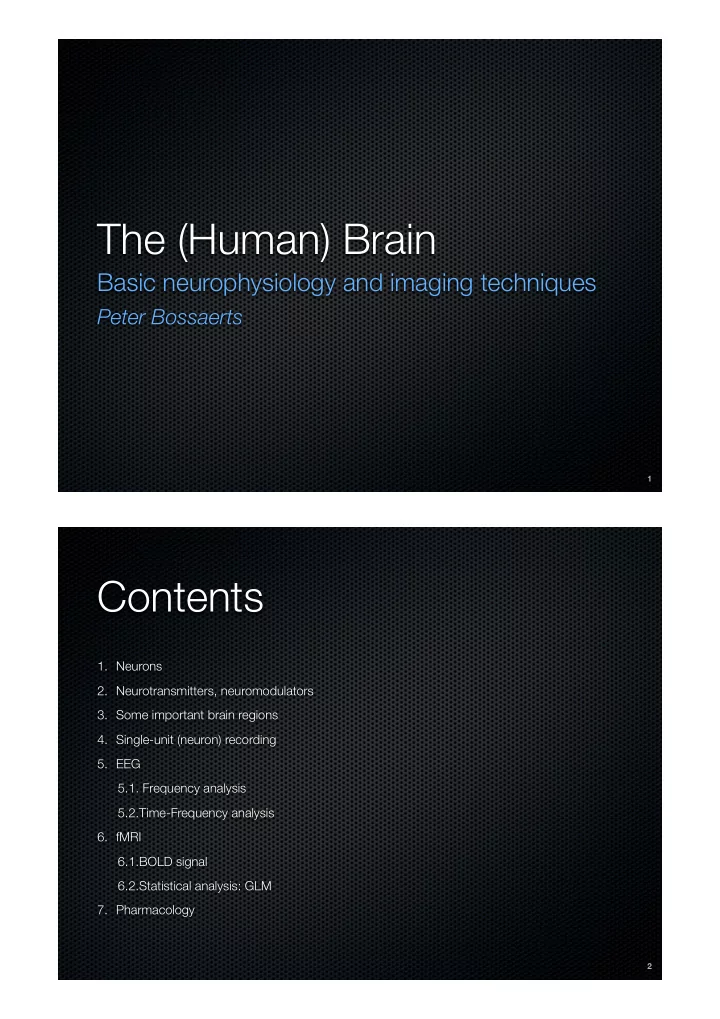

The (Human) Brain Basic neurophysiology and imaging techniques Peter Bossaerts 1 Contents 1. Neurons 2. Neurotransmitters, neuromodulators 3. Some important brain regions 4. Single-unit (neuron) recording 5. EEG 5.1. Frequency analysis 5.2.Time-Frequency analysis 6. fMRI 6.1.BOLD signal 6.2.Statistical analysis: GLM 7. Pharmacology 2
1. Neurons Cells in the brain that carry “information” are called neurons (There are other cells, such as glial cells like astrocytes,...) Information carried within cell body (dendrites, nucleus, axon) is electrical (ions) Across neurons, through synapse (synaptic cleft) it is chemical 3 2. Neurotransmitters ... carry information from one neuron to another Upstream cell emits neurotransmitter that attached to receptors of downstream cell – if not blocked by an “antagonist” – and causes downstream cell to “fire” (a temporary charge surge traveling through the cell) Upstream cells emit particular neurotransmitters, eg GABA, dopamine, serotonin, norepinephrine, acetylcholine, histamine,... 4
5 Some are really “neuromodulators” These neurotransmitters don’t really relay information but regulate information transmission Eg dopamine 6
Example: Dopamine Gives sensation of “arousal” Sub-cortical neurons (brain stem!), with extensive projections, including to prefrontal cortex Affected by cocaine, alcohol, amphetamines,... and L-Dopa 7 3. Some Important 7 Brain Regions “Gray matter” = cell bodies (nucleus); “white mm matter” = “connections” (axons) Cortex, subcortical 9 regions, brainstem view) 8
More... mPFC = medial Prefrontal Cortex ACC = Anterior Cingulate Cortex IFG = Inferior Frontal Gyrus IPS = Interparietal Sulcus TPJ = Temporo-Parietal Junction pSTS = posterior Superior Temporal Sulcus AI = anterior Insula 9 4. Single-Unit Recording Electrode is inserted and tip located close to neuron of interest Invasive, so mostly done on animals (eg monkeys) Record “firing” of neurons (surges of voltage within neuron) 10
Typical Results ... from Wolfram Schultz’ lab Recordings from dopamine neurons in substantia nigra 11 Can Provide Very Detailed Info: “Adaptive Encoding:” Firing of dopamine neurons at reward delivery is SCALED by risk (reward VARIANCE) ... which is the optimal way to encode prediction errors! (Fiorillo, Tobler, Schultz, Science 2005) 12
5. EEG � � � � � � � � � Record electric activity at � �� nodes positioned on scalp � � to the first electrode (see Fig 3). (10 to more than 100) Current recorded is small – millivolts, even microvolts – but significant � (Since electric current creates � magnetic field, could also record magnetic field: MEG) � � 13 � � � � � � � � � � � � � � � � � � � � � � � � � � � � � � � � � � � � � � � 5.1. Frequency Analysis � � � � � � � � � � � � � � Disentangle EEG time series at a node in terms of amplitudes for different frequencies Table 1 . Type of Brain wave (Frequency BANDS) 14
Frequency Analysis: The Principle Every time series can be written as the sum of sine waves with different periodicity (frequency) and amplitude... 15 But Often The Amplitudes Change... Need to do LOCAL analysis ... use time- frequency analysis! 16
5.2. Time-Frequency Analysis 17 (About Localization) Previous slide: localization of source of EEG signal displayed Very tricky to determine this... one needs to solve an inverse problem: many sources could potentially give rise to signal at scalp! (In previous slide: use fMRI localization results as PRIOR in Bayesian analysis of EEG signals at multiple electrodes) While EEG has superb time resolution (ms), it is difficult to perform source localization. For that, we may want to use fMRI. But fMRI: 1. Has bad time resolution 2. Only reveals signals in high-frequency bands (so misses out on the lower frequency electric activity) 18
6. functional Magnetic Resonance Imaging Exploits “resonance” of atoms with odd number of protons/neurons (eg Oxygen) when exposed to a magnetic pulse Done in “layers” across the brain, within ~2s, each layer presenting “voxels” Resulting BOLD (Blood Oxygen Level Dependent) time series, per voxel, is analyzed using GLM (General Linear Model) Only voxels with significant effects are retained and plotted against a structural scan of the brain: “Statistical Parametric Map” 19 Not Invasive, But: Noisy Claustrophobic Magnetic field is dangerous (3 Tesla usually) (Coolant is too!) 20
Recommend
More recommend